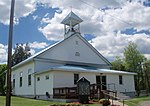Egypt Valley Wildlife Area

The Egypt Valley Wildlife Area is a 14,300 acres (5,800 ha) former surface mining area in northwestern Belmont County Ohio, United States. Since the mid-1990s, the Ohio Department of Natural Resources has administered the area. For many years, local residents have fished, hunted, camped and explored the high walls, backwaters, and graveyards that make up this area. People, to a lesser extent, call the area Egypt Bottom.The area encompasses the northwest corner of Belmont County. Morristown and Hendrysburg are on the southern edges of the area, while Holloway and Flushing are on the northern edge of the area. The southern end of Piedmont Lake, the opposite end of the dam in Piedmont, juts into the northern pocket of the area as well.
Excerpt from the Wikipedia article Egypt Valley Wildlife Area (License: CC BY-SA 3.0, Authors, Images).Egypt Valley Wildlife Area
Geographical coordinates (GPS) Address Nearby Places Show on map
Geographical coordinates (GPS)
| Latitude | Longitude |
|---|---|
| N 40.116152 ° | E -81.117581 ° |
Address
Belmont County
Ohio, United States
Open on Google Maps






